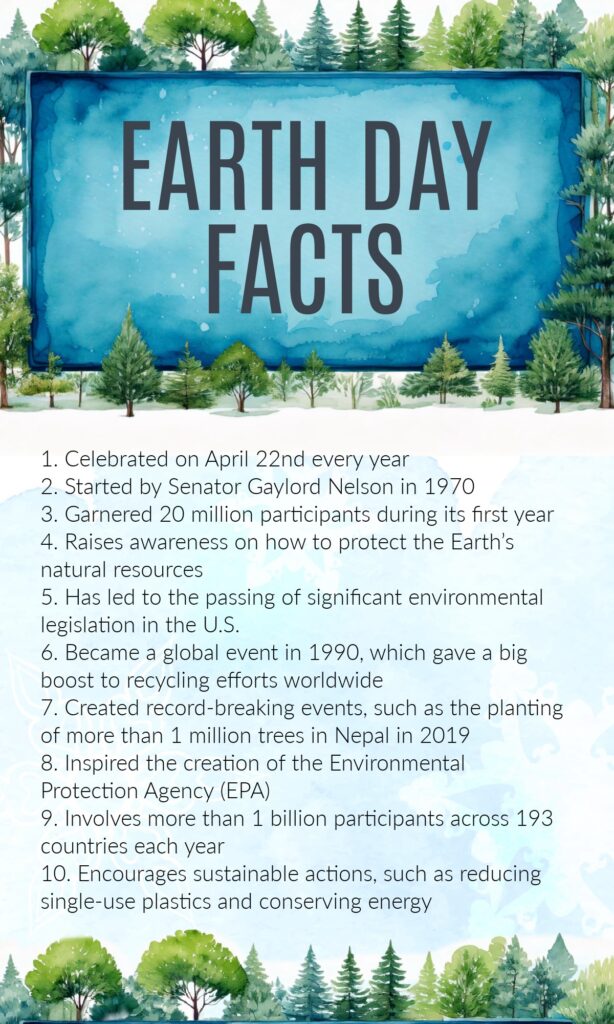Earth Day Facts for Kids
We’ve shared hundreds of engaging nature activities and projects over the last 14 years. But recently one of our homeschool friends asked about the origins of Earth Day, and I realized we’ve never covered that part in detail. So, here’s a look at some interesting Earth Day facts for kids.

Because you’re reading a natural parenting magazine, you’re probably pretty well versed in green living. But it’s always fun to learn more about the history of this holiday.
Personally I think the best thing about it is that many schools celebrate. My single plea is that teachers take kids OUTSIDE to observe Earth Day. Children don’t really get to experience the beauty of nature by sitting in a classroom making a clay model of the earth.
So, whether at school or home, learning these facts about the earth geared towards kids makes a great outdoor education session.
Fun Facts About Earth Day
These are fun Earth Day facts about the origin of the holiday and why it began.
With international recognition, and some political policies now supporting the environment, Earth Day has come a long way since its humble roots.
- Earth Day is celebrated on April 22nd every year.
- It was founded by U.S. Senator Gaylord Nelson. He was inspired to organize a national day of environmental education and activism after the 1969 oil spill in Santa Barbara, California.
- The first Earth Day celebration was in 1970.
- This date was chosen specifically so students could participate in Earth Day rallies and activities, since it wouldn’t intrude on spring break or final exams.
- The purpose of Earth Day is to raise awareness of the harm of environmental damage and how to protect the Earth’s natural resources.
- The first Earth Day led to the passage of significant environmental legislation in the United States, including the Clean Air Act, Clean Water Act, and the establishment of the Environmental Protection Agency (EPA).
- Earth Day became a global event in 1990, which gave a big boost to recycling efforts worldwide.
- Each year, Earth Day has a specific theme or focus chosen by the Earth Day Network to highlight pressing environmental issues and encourage action. Themes range from climate change to biodiversity conservation and sustainable living.
- In 2009, the term International Mother Earth Day was adopted. The term “Mother Earth” was added to emphasize the idea that our planet is not just a resource to be exploited but a living system that sustains life and deserves care and respect.
- Earth Day has seen some record-breaking events, such as the planting of more than 1 million trees in Nepal in 2019 as part of the “Plant for the Planet” campaign, setting a Guinness World Record for the most trees planted simultaneously in a single location.
Earth Day Facts About Trees
Forests are an extremely important part of Mother Earth’s health, and they support ecosystems that we all rely on. Reforestation helps to fight against climate change, and keeps the benefits that forests provide intact.
- Earth Day tree planting is a great way for humans to connect with the environment and help the earth stay healthy with trees. You can sign up to get a free tree for kids to plant on Earth Day through Neighborhood Forest!
- A tree takes 10-20 years before its effect on the environment makes a difference, so it is important to give trees time and protected space to grow.
- Forests play an important role in the food chain for many species.
- More than 28,000 species of forest plants are used in medicines.
Endangered Species Facts
Many animals and plants are massively declining in population due to the negative effects of human civilization. There is a dramatic decline of bees causing concern for the pollination of foods we all eat.
- Insect populations, including important pollinators, have globally declined by 40%.
- Worldwide animal populations have declined by 70% in just the last 50 years.
- In the years spanning from 2006-2015, there was a 25% decline in species of bees.
- One third of the world’s food supply relies on bees to pollinate it.
You can help by raising mason bees and planting a pollinator garden in your backyard! Mason bees don’t require you to wear any protective gear. Plus they are extraordinary pollinators.
Environmental Issues
The amount of litter and plastic making its way into our ecosystems is a growing threat to human health as well as environmental health. These Earth Day facts are important to help reduce single use plastics.
- On average, Americans buy enough plastic water bottles that add up to 13 bottles per month for every single person in the country. One person using a reusable water bottle saves 156 plastic bottles a year.
- Fourteen million tons of plastic go into the oceans every single year, harming wildlife and releasing toxins.
- Across the world, one million water bottles are purchased every minute.
- Twenty percent of the world’s litter is cigarette butts, and there are about 4 billion of them in waterways.
Earth Day Facts and Impacts
Along with Earth Day Facts and researching positive actions to take as a family, there are many valuable life lessons from Earth Day to incorporate along the way. International Mother Earth Day is a celebration, but the actions can last all year long and the impacts are felt globally.
There are so many ways now to celebrate and internalize the lessons, facts, and importance of Earth Day for kids and adults. Get your kids familiar with the idea by reading Earth Day books together or coloring these Earth Day coloring pages together.
When celebrating Earth Day with your kids, spending time outside is an easy way to make an impact by connecting with nature


